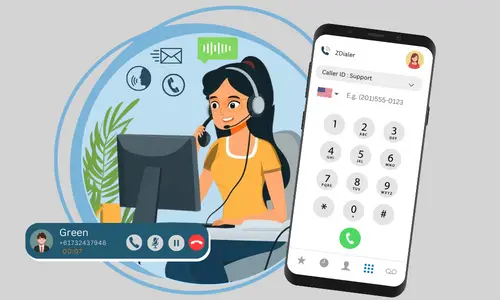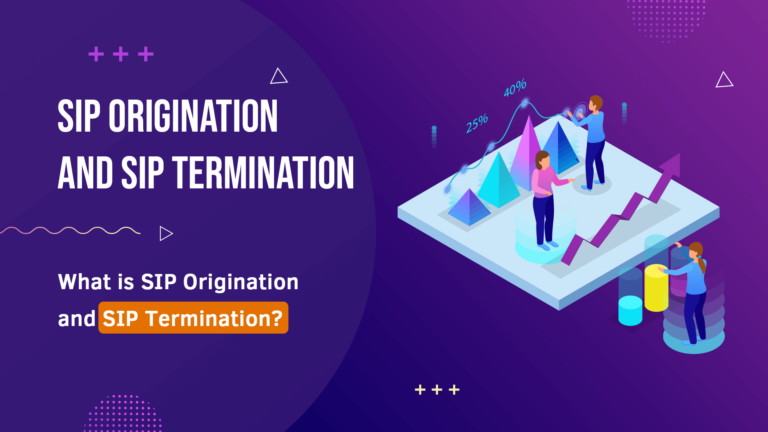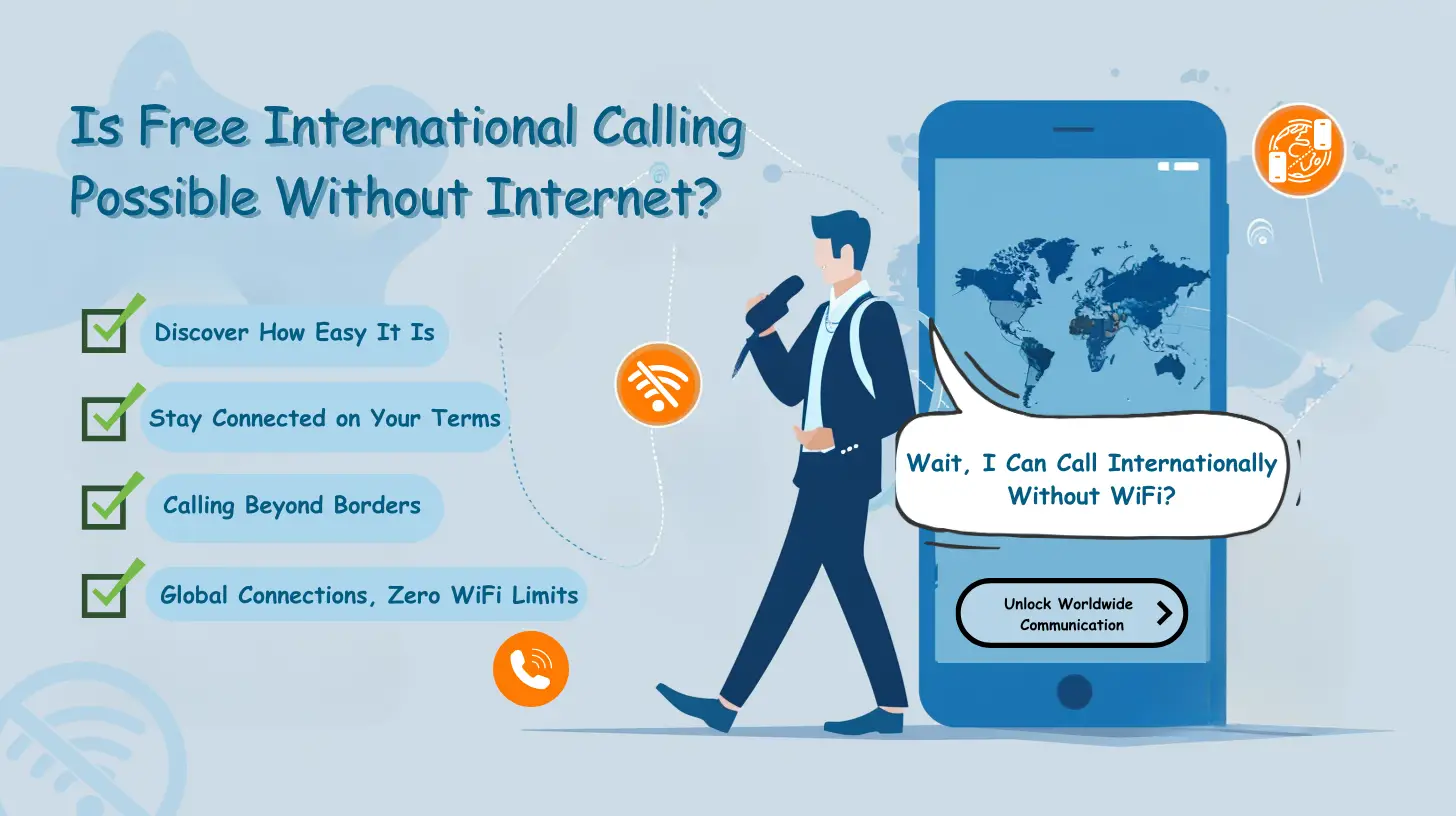What is SIP Origination and SIP Termination?
Have you ever wondered how businesses are able to make and receive phone calls over the Internet? Or how call routing works in voice-over-internet protocol (VoIP) services? The answer lies in SIP origination and SIP termination.
SIP origination and SIP termination are two crucial components in IP telephony, enabling businesses to seamlessly connect and communicate with their clients and customers. But what exactly are SIP origination and SIP Egress, and how do they work?
In this article, we will delve into the world of SIP origination and SIP Egress, exploring their importance in IP telephony and understanding their functionalities. Whether you’re a business owner looking to enhance your communication systems or simply curious about the technology behind VoIP, this article will provide you with the answers you seek.
Key Takeaways:
- SIP origination and SIP termination are essential in IP telephony and VoIP services.
- They enable businesses to make and receive phone calls over the Internet.
- SIP origination deals with incoming calls, while SIP Egress handles outbound calls.
- Both SIP Ingress and SIP termination rely on session initiation protocol (SIP) for call routing and signaling.
- By understanding SIP Ingress and SIP Egress, businesses can enhance their communication systems and achieve cost-effective voice communications.
Understanding IP Telephony
IP telephony, also known as Voice over Internet Protocol (VoIP), is a communication technology that enables voice calls to be transmitted over the Internet rather than traditional phone lines. With IP telephony, businesses can take advantage of internet phone services to make and receive phone calls using their existing internet connection.
VoIP services provide a range of features that enhance communication capabilities for businesses. These services leverage the power of the internet to deliver high-quality voice calls and offer advanced functionalities like call routing, voicemail, call forwarding, and conference calling. By using VoIP services, companies can streamline their business phone services and enjoy cost savings compared to traditional telephony solutions.
The benefits of IP telephony go beyond cost savings. Internet phone service allows businesses to have a more flexible and scalable phone system. It enables employees to connect from anywhere with an internet connection, facilitating remote work and improving collaboration. Additionally, IP telephony integrates with other communication tools and software applications, allowing for seamless integration with existing business workflows.
Benefits of IP Telephony:
- Cost savings compared to traditional phone services.
- Flexible and scalable phone system.
- Improved accessibility and mobility for employees.
- Integration with other communication tools.
- Enhanced collaboration and productivity.
By leveraging IP telephony, businesses can optimize their communication infrastructure, improve efficiency, and stay connected in an increasingly digital world. The next sections will delve deeper into the various aspects of IP telephony, including SIP Ingress and termination, to provide a comprehensive understanding of this modern communication technology.
The Basics of Session Initiation Protocol
Session Initiation Protocol (SIP) is a vital component of modern communication systems. It is a signaling protocol used for initiating and managing communication sessions over IP networks. SIP plays a crucial role in establishing connections between users, enabling them to make voice and video calls, send instant messages, and engage in other multimedia communications.
One key aspect of SIP is its ability to facilitate SIP call routing. This process involves determining the optimal path for connecting a call from the sender to the recipient. Through SIP call routing, SIP solutions ensure efficient and reliable communication by selecting the most suitable route based on factors such as cost, quality, and availability.
SIP signaling is another essential function of the protocol. It controls and coordinates the communication process by exchanging information between users and the network elements involved, such as SIP servers and endpoints. SIP signaling enables call setup, modification, and termination, ensuring seamless communication experiences.
One of the notable advantages of SIP is its flexibility and scalability. It empowers organizations to adapt their communication systems to their specific needs and easily accommodate changing requirements. With SIP solutions, businesses can easily add or remove users, integrate new technologies, and expand their communication capabilities as their operations evolve.
| Benefits of Session Initiation Protocol (SIP) |
| Flexible and scalable communication systems |
| Efficient SIP call routing for optimal connectivity |
| Seamless and reliable communication sessions |
| Supports voice and video calls, instant messaging, and multimedia communications |
| Enables integration with different devices and technologies |
By leveraging SIP call routing, signaling, and its inherent flexibility, organizations can enhance their communication infrastructure, reduce costs, and improve productivity. Whether it’s a small business or a large enterprise, understanding the basics of Session Initiation Protocol is the foundation for building efficient and future-proof communication systems.

SIP Origination Explained
SIP origination plays a crucial role in enabling businesses to receive incoming calls over the internet. It is a fundamental aspect of voice over IP (VoIP) systems, allowing organizations to establish a seamless communication network. In this section, we will explore the ins and outs of SIP Ingress and delve into its significance in the realm of IP telephony.
The Role of SIP Providers
A vital component of SIP Ingress is the involvement of dedicated SIP providers. These providers offer the necessary infrastructure and services to establish and maintain SIP connections, ensuring smooth call origination. They act as intermediaries between the transmitting and receiving parties, facilitating the exchange of voice data over the Internet.
SIP providers are responsible for routing incoming calls from traditional phone networks to the recipient’s VoIP system. They handle the necessary protocol conversions and ensure seamless integration between different communication technologies. By leveraging the expertise of SIP providers, businesses can effectively receive and manage incoming calls over IP networks.
Hosted SIP Services
In addition to SIP providers, hosted SIP services are another integral aspect of SIP Ingress. Hosted SIP services offer businesses the flexibility of outsourcing their entire SIP infrastructure to reliable service providers. This eliminates the need for businesses to handle complex hardware and software setups themselves.
With hosted SIP services, businesses can leverage the expertise of experienced professionals who manage and maintain the required SIP infrastructure. This frees up valuable resources and allows organizations to focus on their core competencies. Additionally, hosted SIP services offer scalability, ensuring that businesses can easily accommodate growth and increased call volumes.
The image above illustrates the concept of hosted SIP services in action. With a centralized SIP infrastructure managed by a service provider, businesses can seamlessly receive incoming calls over the Internet, enhancing their overall communication efficiency.
The Process of SIP Call Origination
Now, let’s take a closer look at the process of SIP call origination. When a caller initiates an outgoing call, their VoIP phone or device sends a SIP invite request to the SIP provider. This request contains the necessary information, such as the caller’s identity and the recipient’s contact details.
The SIP provider then looks up the recipient’s information and forwards the call request to their VoIP system. The call is then established, allowing the caller and recipient to communicate seamlessly through the SIP infrastructure.
In essence, SIP Ingress simplifies the process of receiving incoming calls over the Internet by leveraging the expertise of SIP providers and utilizing hosted SIP services. This ensures that businesses can enjoy efficient and cost-effective communication while focusing on their core operations.
Summary
In this section, we explored the concept of SIP Ingress and its significance in enabling businesses to receive incoming calls over the Internet. We discussed the role of SIP providers in routing calls and the benefits of utilizing hosted SIP services. The process of SIP call origination was also explained, highlighting the seamless exchange of voice data through the SIP infrastructure.
| Benefits of SIP Origination | Explanation |
| Cost savings | SIP origination allows businesses to transmit and receive calls over the Internet, eliminating the need for traditional phone lines and reducing communication costs. |
| Flexibility | With SIP origination, businesses can easily scale their communication infrastructure to accommodate changing needs and call volumes. |
| Reliability | SIP Ingress offers a stable and reliable communication channel, ensuring high call quality and minimizing disruptions. |
| Seamless integration | By leveraging the SIP infrastructure, businesses can integrate their communication systems seamlessly, enhancing overall efficiency. |
Benefits of SIP Origination
SIP origination offers numerous benefits for businesses, revolutionizing their communication systems and driving efficiency. By leveraging this technology, companies can experience cost savings, scalability, and flexibility in their voice communications.
Cost Savings
One of the key advantages of SIP Ingress is the potential for significant cost savings. Traditional phone systems often involve high setup costs, maintenance fees, and long-distance charges. With SIP Ingress, calls are transmitted over the internet, eliminating the need for expensive physical infrastructure. Businesses can enjoy lower rates for domestic and international calls, resulting in substantial cost reductions on their phone bills.
Scalability
SIP Ingress enables businesses to easily scale their communication systems as their needs evolve. Unlike traditional phone lines that require physical installation and configuration, SIP Ingress operates through virtual channels. This means that adding or removing phone lines can be done quickly and seamlessly, without the need for on-site technicians. Whether a business experiences rapid growth or downsizing, SIP Ingress provides the flexibility to adapt its communication infrastructure accordingly.
Flexibility
Another advantage of SIP Ingress is the flexibility it brings to businesses. With SIP services, companies have the freedom to choose their preferred phone service providers, allowing them to negotiate better call rates and access advanced features. Additionally, SIP Ingress supports mobility, enabling employees to connect and communicate from anywhere with an internet connection. This flexibility empowers businesses to optimize their communication processes and enhance collaboration among teams.
Overall, SIP Ingress empowers businesses with cost savings, scalability, and flexibility in their communication systems. By embracing this technology, companies can optimize their voice communications, streamline operations, and focus on driving growth.
How SIP Origination Works
SIP origination is a key component of IP telephony that allows businesses to receive incoming calls over the internet. Understanding how the process works is crucial for optimizing communication systems and ensuring seamless call routing. In this section, we will delve into the intricacies of SIP Ingress, highlighting the role of SIP providers and sip trunking.
The Process of SIP Origination
- Call Initiation: When a caller dials a phone number, their request is sent to the SIP provider’s network via the internet.
- SIP Trunking: The SIP provider receives the call request and establishes a connection between the caller’s device and the internet. This is achieved through SIP trunking, which allows for the transmission of voice data over an IP network.
- Call Routing: The SIP provider routes the incoming call to the appropriate destination based on predefined rules. These rules can include factors such as time of day, caller ID, or specific extensions within the business.
- Destination Identification: The SIP provider determines the intended recipient of the call based on the routing rules. This could be an individual extension, a department within the organization, or an automated voice response system.
- Call Delivery: Once the destination is identified, the call is delivered to the recipient’s device or phone system, allowing them to answer and engage in a conversation.
The Role of SIP Providers
SIP providers play a crucial role in SIP Ingress by acting as intermediaries between the caller and the callee. They facilitate the routing of incoming calls and ensure efficient and reliable communication. These providers typically offer a range of services that support SIP Ingress, including:
- Phone number provisioning
- Call routing and forwarding
- Call management features
- Integrations with existing phone systems
By partnering with a reputable SIP provider, businesses can leverage their expertise and infrastructure to streamline their communication processes.
Benefits of SIP Origination
SIP origination offers numerous benefits for businesses seeking cost-effective and flexible communication solutions. Some of the key advantages include:
- Cost savings: By routing calls over the Internet, businesses can significantly reduce their telecommunication expenses, especially for long-distance and international calls.
- Scalability: SIP Ingress allows businesses to easily scale their communication systems up or down to accommodate changing needs and growth.
- Flexible call routing: With SIP Ingress, businesses have the flexibility to customize call routing rules based on their unique requirements, ensuring calls are directed to the right individuals or departments.
Overall, SIP Ingress empowers businesses with the ability to establish a robust and reliable voice communication infrastructure.
| Advantages of SIP Origination | Benefits |
| Cost savings | Significantly reduce telecommunication expenses |
| Scalability | Easily scale communication systems to accommodate growth |
| Flexible call routing | Customize routing rules for efficient call delivery |
SIP Termination: Outbound Call Routing
SIP termination plays a crucial role in enabling businesses to make outbound calls over the Internet. It provides a cost-effective solution for organizations seeking to streamline their communication processes and reduce operational expenses. By leveraging session initiation protocol termination (SIP Egress) services, businesses can ensure seamless connectivity and high-quality voice communication with their clients, customers, and partners.
One of the key components of SIP Egress is SIP trunking. This technology allows businesses to route outgoing calls through a SIP provider, converting analog voice signals into digital packets that can be transmitted over the Internet. By utilizing SIP trunking services, companies can eliminate the need for traditional phone lines and benefit from significant cost savings.
The advantages of SIP trunking for outbound call routing are multifold. Firstly, it allows businesses to scale their communication infrastructure without incurring additional hardware costs. With traditional telephony systems, adding more phone lines would involve costly equipment installations. However, with SIP trunking, organizations can easily expand their call capacity by simply adjusting their SIP trunking configuration.
Moreover, SIP Egress not only enables businesses to make calls to traditional phone numbers but also supports connectivity with other SIP-enabled devices and platforms. This flexibility allows for seamless integration with various communication solutions, such as IP telephony systems and VoIP services.
Benefits of SIP Termination and Outbound Call Routing:
- Cost savings: SIP termination eliminates the need for expensive hardware installations and reduces long-distance call charges, resulting in substantial cost savings for businesses.
- Scalability: With SIP trunking, organizations can easily scale their call capacity up or down to meet changing communication needs, ensuring efficient resource allocation.
- Global reach: SIP Egress allows businesses to establish local presence in different geographical locations by routing outbound calls through SIP providers in those regions.
- Enhanced call quality: By leveraging SIP Egress services, businesses can enjoy improved call clarity and reduced latency, ensuring crystal-clear voice communication.
| Advantages of SIP Termination | Benefits |
| Cost savings | Significant reduction in long-distance call charges and hardware costs. |
| Scalability | Easy expansion or contraction of call capacity to meet changing demands. |
| Global reach | Establishing a local presence in different regions for better customer engagement. |
| Enhanced call quality | Improving voice clarity and reducing latency for better communication experiences. |
Overall, SIP Egress and outbound call routing through SIP trunking provide businesses with a reliable and cost-effective solution for their voice communication needs. By embracing these technologies, organizations can empower their communication infrastructure, enhance productivity, and deliver exceptional customer experiences.
Advantages of SIP Termination
SIP termination, also known as Session Initiation Protocol termination, offers a multitude of advantages for businesses looking to optimize their voice communication systems. By leveraging voice-over-internet protocol (VoIP) technology, businesses can experience cost savings, global reach, and enhanced call quality.
Cost Savings
SIP termination eliminates the need for traditional phone lines, reducing infrastructure costs and eliminating long-distance charges. By routing calls over the internet, businesses can significantly reduce their telecommunications expenses, especially for international calls. This cost-effective solution allows businesses to allocate their budget more efficiently and invest in other areas of growth.
Global Reach
With SIP termination, businesses can expand their reach beyond local boundaries and establish a global presence. By utilizing SIP services, companies can connect with customers, partners, and employees anywhere in the world through internet-enabled devices. This enables seamless communication and collaboration, regardless of geographical barriers, facilitating international business growth and expansion.
Enhanced Call Quality
SIP termination ensures high-quality voice communication by transmitting calls through a reliable and robust IP network. This technology prioritizes call quality, resulting in clearer voice transmission, reduced latency, and minimized call drops. The use of advanced codecs and quality of service (QoS) protocols further enhances call clarity, making conversations more natural and uninterrupted.

By leveraging SIP Egress, businesses can reap the benefits of streamlined communication, reduced costs, and improved customer satisfaction. VoIP service providers offer a range of SIP services tailored to meet the unique needs of businesses, providing them with a competitive edge in the market.
The Process of SIP Egress
SIP Egress is a crucial aspect of IP telephony that enables businesses to make outbound calls over the Internet using the Session Initiation Protocol (SIP). The process of SIP Egress involves routing and delivering these calls to their intended recipients efficiently and reliably.
Step 1: Initiating the Call
The first step in the SIP Egress process is initiating the call from the originating device. The device sends a request to the SIP gateway or provider to establish a communication session. This request contains the necessary information, such as the destination address and the desired audio and video codecs.
Step 2: Routing the Call
Once the SIP gateway or provider receives the call request, it analyzes the destination address to determine the appropriate route for the call. This routing decision is based on various factors, including cost, call quality, and geographic location. The gateway or provider then selects the most efficient route to the recipient’s network.
Step 3: Establishing the Session
After determining the route, the SIP gateway or provider establishes the communication session with the recipient’s network. This involves negotiating the audio and video codecs supported by both parties and ensuring compatibility. The session initiation is facilitated through SIP messages, which handle the signaling and control of the call.
Step 4: Transmitting the Media
Once the session is established, the SIP Egress process involves transmitting the audio and video media between the originating and recipient devices. The media streams flow through the established communication path, ensuring the real-time exchange of voice and video data.
Step 5: Monitoring the Call
During the call, the SIP Egress process includes monitoring the quality and performance of the communication session. This includes measuring factors such as call quality, latency, and packet loss to ensure optimal voice and video transmission. If any issues arise, the SIP gateway or provider can take appropriate measures to mitigate them and maintain call quality.
Step 6: Call Completion and Billing
Once the call is completed, the SIP Egress process includes generating the necessary billing records and closing the session. These billing records include information about the duration, destinations, and charges associated with the call. Businesses can then use these records for accurate accounting and cost management.
The process of SIP Egress is essential for businesses looking to leverage IP telephony for cost-effective and efficient outbound calling. By understanding this process, businesses can effectively implement and manage their SIP Egress services to optimize their communication systems.
Choosing a SIP Provider
When it comes to implementing SIP Ingress and termination for your business, choosing the right SIP provider is crucial. A reliable and efficient SIP provider can streamline your communication systems and enhance your overall business operations. To help you make an informed decision, consider the following factors:
1. Call Quality
The call quality offered by a SIP provider is paramount. Look for providers that prioritize reliable voice connections with high-definition sound. Checking customer reviews and ratings can provide valuable insights into the call quality experienced by other businesses.
2. Pricing
Compare the pricing structures of different SIP providers to ensure they align with your budget and requirements. Consider any additional fees or charges, such as setup costs, monthly subscriptions, or pay-per-minute rates. The goal is to find a balance between cost-effectiveness and quality.
3. Customer Support
Having access to reliable customer support is essential in case of any issues or technical difficulties. Look for SIP providers that offer 24/7 customer support through various channels such as phone, email, or live chat. Prompt and efficient support can minimize downtime and ensure seamless communication.
4. Available Features
Consider the features offered by different SIP providers and how they align with your communication needs. Look for features such as virtual attendants, call forwarding, call analytics, and voicemail transcription. Understanding your specific requirements will help you choose a provider that offers the necessary features.
5. Scalability and Flexibility
As your business grows, it’s important to choose a SIP provider that can scale its services to accommodate your evolving needs. Look for providers that offer flexible plans and can easily adapt to changes in call volume or business expansion.
| SIP Provider | Call Quality | Pricing | Customer Support | Available Features | Scalability and Flexibility |
| My Country Mobile | Excellent | Competitive | 24/7 phone and email support | Virtual attendants, call forwarding, call analytics, voicemail transcription | Flexible plans for business growth |
| Vonage | Good | Affordable | Email support during business hours | Basic features | Limited scalability options |
| Ace Peak | Excellent | Premium pricing | 24/7 phone, email, and live chat support | Advanced features with customization options | Scalable plans for business expansion |
Keep in mind that finding the right SIP provider is a decision that requires careful evaluation of your specific business needs. By considering factors such as call quality, pricing, customer support, available features, and scalability, you can ensure that you choose a reliable partner for your SIP Ingress and termination needs.
SIP Origination vs. SIP Termination: Key Differences
When it comes to IP telephony and VoIP services, understanding the differences between SIP origination and SIP termination is essential for businesses. While both SIP Call Inception and SIP Egress play crucial roles in supporting effective communication systems, they serve distinct purposes. Let’s explore the key differences between these two concepts.
SIP Origination:
SIP origination refers to the process of receiving incoming calls over the Internet using a Session Initiation Protocol (SIP) provider. It enables businesses to establish a connection with external callers, facilitating seamless communication. SIP Call Inception is often used to enhance IP telephony systems by routing inbound calls to the appropriate recipients within the organization.
SIP Egress:
In contrast, SIP termination enables businesses to make outbound calls over the Internet. It involves the routing of calls from the organization’s internal IP network to the recipient’s traditional telephone network. SIP Egress provides a cost-effective solution for making long-distance or international calls, leveraging the benefits of VoIP technology.
While both SIP Call Inception and SIP Egress are integral parts of SIP trunking systems, they differ in terms of directionality and purpose. SIP Call Inception focuses on receiving incoming calls, ensuring effective call routing within the organization. On the other hand, SIP Egress facilitates outbound calling, offering businesses a cost-efficient way to connect with external contacts.
Comparison between SIP Origination and SIP Termination:
| SIP Origination | SIP Termination |
| Receives incoming calls from external sources | Enables outbound calls to external recipients |
| Routes inbound calls to the appropriate recipients within the organization | Routes outbound calls from the organization’s internal network to the recipient’s traditional telephone network |
| Enhances IP telephony systems | Offers cost-effective long-distance and international calling |
| Focuses on call reception and internal call routing | Facilitates outbound call connections |
Understanding the distinctions between SIP Call Inception and SIP Egress allows businesses to choose the right solution based on their specific communication requirements. Whether the goal is to optimize inbound call routing or to minimize calling costs, both SIP Call Inception and SIP Egress contribute to efficient and effective voice communication systems.
By selecting the appropriate SIP trunking services and providers, businesses can leverage the benefits of both SIP Call Inception and SIP Egress to elevate their IP telephony solutions, reduce communication costs, and improve overall connectivity.
SIP Origination and SIP Termination Best Practices
Implementing SIP origination and SIP Egress requires careful consideration and adherence to best practices. By following these guidelines, businesses can ensure a smooth and efficient communication system.
1. Network Security
Securing the network infrastructure is of paramount importance when implementing SIP Call Inception and SIP termination. Use firewalls, encryption, and strong authentication protocols to protect against unauthorized access and potential security threats.
2. Call Quality Optimization
Ensure optimal call quality by prioritizing network bandwidth and implementing Quality of Service (QoS) measures. This helps to minimize latency, jitter, and packet loss, resulting in clear and reliable voice communication.
3. Efficient Call Routing Strategies
Design an efficient call routing strategy to minimize call drops and improve call completion rates. Implement intelligent routing algorithms that consider factors such as cost, network availability, and call quality to deliver calls to the most appropriate destinations.
4. Regular Monitoring and Maintenance
Monitor the performance of SIP Call Inception and termination systems regularly. This includes analyzing call data, troubleshooting issues promptly, and conducting periodic maintenance to ensure optimal system functionality.
5. Redundancy and Disaster Recovery
Implement redundancy and disaster recovery mechanisms to ensure uninterrupted communication. Have backup systems in place, such as redundant SIP trunks and failover mechanisms, to mitigate the impact of network failures or natural disasters.
By following these best practices, businesses can fully leverage the benefits of SIP Call Inception and SIP Egress, including cost savings, scalability, and enhanced communication capabilities.
Case Studies: Successful Implementation of SIP Origination and Termination
Real-life examples serve as valuable demonstrations of how SIP Call Inception and termination can be effectively implemented to improve communication systems. By analyzing these case studies, businesses can gain insights into the benefits achieved and the strategies employed to ensure a successful transition. Let’s explore some of these success stories:
Case Study 1: Teloz
Company teloz, a leading e-commerce platform, was facing significant challenges with its existing phone system. They decided to adopt SIP Call Inception and termination to enhance their communication capabilities. By partnering with a reliable SIP provider, they were able to receive incoming calls over the Internet, resulting in improved call quality and cost savings. With the scalability offered by sip trunking, their communication system seamlessly adapted to their growing customer base. As a result, Teloz experienced increased customer satisfaction and realized substantial cost efficiencies.
Case Study 2: callmama
callmama, a multinational corporation, recognized the potential of SIP Call Inception and termination to streamline their global communication infrastructure. By implementing SIP trunking and utilizing the services of a reputable sip provider, they achieved significant cost savings for their outbound calls. The flexibility and scalability of SIP Egress allowed callmama to efficiently connect with their international offices, facilitating collaboration and improving overall business operations. In addition, the enhanced call quality and reliability of SIP Egress resulted in improved customer service experiences and increased customer retention.
Case Study 3: Small Business Solutions
Small Business Solutions, a startup with a limited budget, sought an affordable and reliable communication solution that could scale with their growing needs. By adopting SIP Call Inception and termination, they were able to leverage the cost-effective benefits of VoIP services. With SIP trunking, they seamlessly integrated their existing phone system with the internet, enabling them to handle incoming and outgoing calls efficiently. This implementation allowed Small Business Solutions to compete with more established competitors, providing superior customer service and positioning themselves for future growth.
Case Study 4: Educational Institution
An educational institution was looking to streamline its communication processes and reduce expenses. By embracing SIP Call Inception and termination, the institution was able to centralize its phone system, utilizing SIP gateways and session initiation protocol termination for outbound calls. The implementation of SIP services resulted in improved call quality and reduced telecommunication costs. Additionally, the scalability of SIP trunking allowed the institution to easily accommodate fluctuations in call volume during peak periods. The successful implementation of SIP Call Inception and termination significantly enhanced communication efficiency within the institution, benefiting students, staff, and parents alike.
These case studies highlight the significant advantages that businesses and organizations achieve through the successful implementation of SIP Call Inception and termination. By leveraging the power of SIP technology and partnering with reliable service providers, businesses can optimize their communication systems, improve call quality, reduce costs, and enhance customer experiences.
| Benefits | Company ABC | Organization XYZ | Small Business Solutions | Educational Institution |
| Improved Call Quality | ✓ | ✓ | ✓ | ✓ |
| Cost Savings | ✓ | ✓ | ✓ | ✓ |
| Scalability | ✓ | ✓ | ✓ | ✓ |
| Global Reach | – | ✓ | – | – |
| Enhanced Customer Service | ✓ | ✓ | – | ✓ |
| Easy Integration | ✓ | ✓ | ✓ | – |
Future Trends in SIP Origination and Termination
As the telecommunications landscape continues to evolve, the future of SIP origination and termination holds exciting possibilities for businesses. Advancements in session initiation protocol (SIP) technology, combined with integration with emerging technologies, are set to transform the way organizations communicate. These trends in SIP solutions and IP telephony promise improved efficiency, enhanced connectivity, and enriched user experiences.
Advancements in Session Initiation Protocol
The evolution of session initiation protocol brings innovative features and capabilities to SIP Call Inception and termination. Enhanced call routing algorithms and improved signalling protocols contribute to more efficient call setups and better call quality. The seamless integration of SIP with advanced network technologies such as 5G and cloud computing enables faster and more reliable communication, paving the way for new possibilities in IP telephony.
Integration with Emerging Technologies
SIP Call Inception and termination are poised to integrate with emerging technologies, shaping the future of business communication. The convergence of SIP and artificial intelligence (AI) opens doors to intelligent call routing, automated call analysis, and advanced voice recognition. Additionally, the integration of SIP with Internet of Things (IoT) devices allows for real-time communication with connected devices, enabling new applications like smart home automation and industry-specific IoT solutions.
Potential Impact on Business Communication
The future trends in SIP Call Inception and termination have the potential to revolutionize business communication. Seamless connectivity between voice, video, and messaging channels will enable unified communication experiences and empower collaboration across geographically dispersed teams. The scalability and flexibility of SIP solutions and VoIP services will support agile business operations, offering cost-effective and scalable communication systems.
| Trend | Description |
| Enhanced Call Routing | Advanced algorithms and protocols for efficient call setups and improved call quality. |
| Integration with AI | Intelligent call routing, automated call analysis, and voice recognition powered by AI. |
| Integration with IoT | Real-time communication with connected IoT devices, enabling new applications and use cases. |
| Unified Communication | Seamless integration of voice, video, and messaging channels for unified communication experiences. |
| Scalability and Flexibility | SIP solutions and VoIP services that support agile business operations and scalable communication systems. |
Conclusion
In conclusion, SIP origination and SIP Egress play crucial roles in the realm of IP telephony. Through session initiation protocol origination, businesses can receive incoming calls over the Internet, enabling seamless and cost-effective voice communications. With the use of SIP trunking and SIP gateways, SIP Call Inception ensures efficient call routing and delivery, enhancing overall communication systems. On the other hand, SIP Egress allows businesses to make outbound calls over the Internet, utilizing the benefits of voice over Internet protocol (VoIP) services and SIP trunking.
By leveraging these technologies, businesses can experience a multitude of advantages. These include cost savings, as IP telephony eliminates the need for traditional phone lines and expensive long-distance charges. The scalability and flexibility offered by SIP Call Inception and termination allow businesses to easily adapt to changing communication needs. Additionally, the use of VoIP services and SIP trunking enhances call quality and enables global reach, ensuring efficient and reliable voice communication.
As businesses strive for efficient and cost-effective communication systems, the importance of SIP Call Inception and SIP Egress cannot be overstated. By choosing reliable SIP providers and implementing best practices for these technologies, businesses can fully harness their potential. With future trends continuously advancing session initiation protocol and its integration with emerging technologies, the future of SIP origination and SIP termination holds even more possibilities for improving business communication.
FAQ
What is SIP Origination and SIP Termination?
SIP origination refers to the process of receiving incoming calls over the Internet using session initiation protocol (SIP). SIP termination, on the other hand, enables businesses to make outbound calls over the Internet. Both SIP Call Inception and termination are essential components of IP telephony, providing cost-effective and scalable solutions for voice communications.
What is IP Telephony?
IP telephony, also known as voice over Internet protocol (VoIP) service, enables businesses to make and receive phone calls over the Internet. It leverages the power of internet connectivity to transmit voice data packets, eliminating the need for traditional phone lines. IP telephony offers numerous benefits, including cost savings, flexibility, and advanced features.
What is Session Initiation Protocol (SIP)?
Session Initiation Protocol (SIP) is a signaling protocol used in IP telephony to establish, modify, and terminate communication sessions. It facilitates the routing of SIP calls, enabling efficient communication between devices and networks. SIP offers flexibility, scalability, and interoperability, making it a popular choice for business phone systems.
How does SIP Origination work?
SIP origination works by using a SIP provider and sip trunking technology to route incoming calls over the internet. When someone dials a phone number, the call is transmitted as SIP packets and received by the SIP provider. The SIP provider then routes the call to the intended recipient by converting the SIP packets into traditional phone signals.
What are the benefits of SIP Call Inception?
SIP Call Inception offers several benefits for businesses. It provides cost savings compared to traditional phone services, as calls are transmitted over the Internet. SIP Call Inception also offers scalability, allowing businesses to easily add or remove phone lines as needed. Additionally, it supports advanced features and integrates well with other SIP services, enhancing overall communication systems.
How does SIP Termination work?
SIP termination enables businesses to make outbound calls over the internet by using SIP trunking. When someone dials an outbound number, the call is converted into SIP packets and transmitted to a SIP provider. The SIP provider then routes the call to the recipient’s network, converting the SIP packets into traditional phone signals for connection.
What are the advantages of SIP Termination?
SIP termination offers several advantages for businesses. It allows for cost-effective outbound calling, as calls are transmitted over the Internet instead of traditional phone lines. SIP termination also provides global reach, enabling businesses to make international calls at lower rates. Additionally, it ensures enhanced call quality and reliability, contributing to efficient and professional communication.
How does the process of SIP Termination work?
The process of SIP termination involves utilizing a SIP gateway and session initiation protocol (SIP) termination. When a call is made, the SIP gateway converts the call into SIP packets and transmits them to the intended recipient’s network. The recipient’s network then converts the SIP packets back into traditional phone signals for the call to be completed.
How should I choose a SIP Provider?
When choosing a SIP provider, it is important to consider several factors. These include call quality, pricing, customer support, available features, and compatibility with your business phone system. Assess your specific communication needs and evaluate different providers to find the one that best suits your requirements.
What are the key differences between SIP Call Inception and SIP Termination?
While both SIP Call Inception and termination are essential components of IP telephony, they serve different purposes. SIP Call Inception is the process of receiving incoming calls over the internet, while SIP termination enables businesses to make outbound calls over the Internet. Each process involves different technologies and plays a vital role in establishing seamless voice communication.
What are the best practices for SIP Call Inception and Termination?
Implementing SIP Call Inception and termination successfully involves following certain best practices. These include ensuring network security, optimizing call quality, implementing efficient call routing strategies, and regularly monitoring and maintaining the SIP infrastructure. It is also recommended to work with experienced SIP solution providers who can offer guidance and support.
Can you provide case studies of successful SIP Origination and Termination implementations?
Certainly! We have several case studies that showcase businesses successfully implementing SIP Call Inception and termination. These examples highlight the benefits achieved, such as cost savings, improved call quality, and enhanced communication efficiency. Contact us for access to these case studies and discover how SIP Call Inception and termination can transform your business communication.
What are the future trends in SIP Call Inception and Termination?
The future of SIP Call Inception and termination is expected to witness advancements in session initiation protocol, increased integration with emerging technologies, and continued innovation in SIP solutions. These trends will contribute to even more efficient, reliable, and feature-rich business communication systems. Stay updated with the latest developments in SIP technology to leverage its full potential for your organization.


























